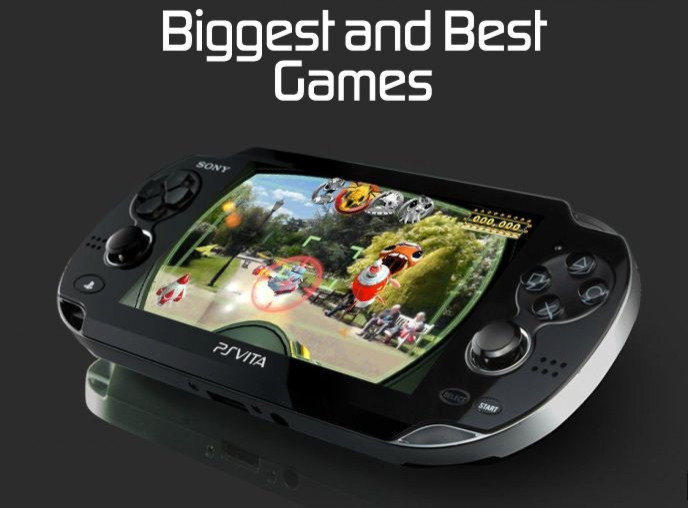Top Reasons Why Sony’s PS Vita Will be the Greatest Handheld Gaming Device on the Planet

PlayStation Vita is the successor to the PlayStation Portable as part of the PlayStation family of gaming devices. The device is set to arrive in Japan and parts of Asia in late 2011. Europe and North America will see an early 2012 release.
Despite a hard competition from Microsoft’s Xbox and Nintendo’s gaming devices, Sony’s PSP has remained extremely popular among gamers for its excellent features.
Here is the list of reasons why the PS Vita will reign supreme as the greatest handheld gaming device on the planet.
Screen Size: Although Sony’s newest PS Vita resembles the previous PSP-3000, it is much more compact in comparison. The handheld device has a wide 5-inch (16.9) OLED screen, with multi-touch display (capacitive type), that provides a resolution of 960×544 pixels that is as good as an Apple iPhone.
The previous PSP-3000 came with a 4.3-inch TFT screen at 480 × 272. The PSP-3000’s display size, alone, was the largest compared to any other handheld gaming device that ever came around. Now Sony will break the barrier that they themselves created with a new 5-inch screen.
Device Processor: The PS Vita has been built with the very powerful ARM Cortex- A9 MPcore (4 core) processor (3 of the 4 cores will be usable for applications) which has evolved from the MIPS R4000 at 1~333 MHz processor which has been the ongoing trend for Sony that was included in all the previous devices.
The Vita, in comparison to the other big player in the market, Nintendo, is more advanced and has enough firepower to see off any kind of competition in the gaming device battle. The latest Nintendo 3DS has been built with a Nintendo ARM after the previous Nintendo DS and Nintendo DS XL featured 33 MHz ARM7 and 133 MHz ARM9 processors, respectively.
User Interface: The Vita has arrived with a unique multi-touch pad on the rear, along with the front touch display for a thrilling gaming experience. The enhanced OLED screen provides for much wider gaming angles without the previous fadeout problem that was common in PSP 3000. Vita has an oval shape that gives the user a better and more comfortable grip of the multi touch pad located at the back of the device.
Other notable features that make the user interface even more attractive is the six-axis motion sensing system, which includes three-axis gyroscope and three-axis accelerometer and three-axis electronic compass. The Vita also features two analog sticks unlike the PSP which features only a single analog nub, and a revolutionary front and rear camera. The two cameras feature the abilities of face detection, head detection and head tracking.
The Nintendo 3DS also has a front-facing and two rear 0.3 MP VGA cameras.
Connectivity: Sony has developed the Vita with the latest Wi-Fi 802.11b/g/n, Bluetooth v2.1+EDR (A2DP/AVRCP/HSP), which supports A2DP for stereo headset and mobile network connectivity for 3G + Wi-Fi model only. For location information, it has a built-in GPS with 3G + Wi-Fi model.
The previous PSP-3000 only came with an 802.11b Wi-Fi, whereas the Nintendo 3DS has an Integrated 802.11b/g with a separate IR port.
Other Features: The PlayStation Vita will be released as two different versions: one with 3G support and a cheaper version without 3G support. The 3G-version, which will be expensive, will also come pre-loaded with some special applications that take advantage of 3G's always-on capabilities, such as the augmented reality software. The 3G service will be partnered with AT&T in the U.S.
Unlike the PSP, Vita will not support video output or contain a removable battery. Sony, however, had confirmed at the TGS 2011 that the battery would last 3-5 hours of gameplay, 5 hours of video, and up to 9 hours of music listening with the screen off. The Vita is equipped with a storage media slot in addition to the NVG card slot, so that users can choose their memory capacity based on the use. The capacities so far have ranged from 4 GB to 32 GB.
Unlike the PSX DVR, PSP and PlayStation 3, the Vita does not use the XrossMediaBar interface. Instead it makes use of a touchscreen-based UI dubbed LiveArea, which includes various social networking features, via the PlayStation Netwo.
Social networking apps, such as Facebook, Skype and Twitter will be available to download for PlayStation Vita free of charge from the PlayStation Store.
© Copyright IBTimes 2024. All rights reserved.





















